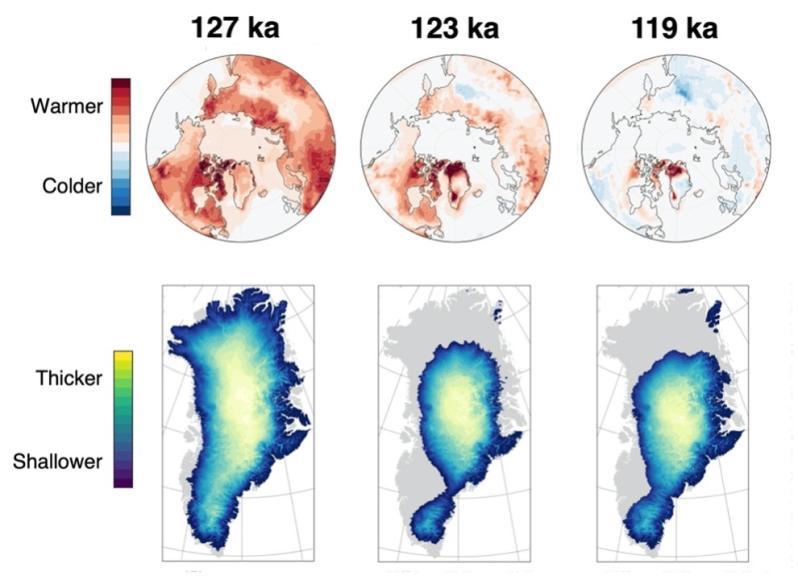
Lead supervisor: Matthew Osman, Geography
Co-supervisor: Francesco Muschitiello, Geography
Brief summary:
This project will reconstruct Greenland Ice Sheet (GrIS) and global temperature change during the Last Interglacial warm period (ca. 127-119 thousand years before present) to better understand the GrIS’s long-term response to warming and its contributions to past and future sea level rise.
Importance of the area of research concerned:
Mass loss from the GrIS is expected to accelerate during the 21st century, impacting ocean circulation and contributing to global sea level rise. However, estimates of the future GrIS contribution to sea level rise vary considerably among models, ranging from ~2 to nearly 100 cm of sea level rise equivalent by 2100 CE under high-emissions scenarios. The study of past warm intervals can help constrain future GrIS responses to human-caused climate change, but the underlying climate proxy networks required to do so are sparse and often disagree with climate model estimates.
The Last Interglacial (LIG) has received close attention due to the fact that, during this period, mean annual Arctic temperatures were similar to modern day values and global sea levels were ~5–10 m higher than present. Yet, large uncertainties remain surrounding the magnitude and spatial expression of LIG warming, and the degree to which the GrIS contributed to LIG global sea level rise. By explicitly pairing globally dispersed proxies with a state-of-the-art, coupled ice sheet—climate model for the LIG, this project will develop internally consistent constraints to reconcile these uncertainties.
Project summary :
This project will produce a paleoclimate “reanalysis” – a dynamically consistent, observationally constrained, and spatially complete reconstruction – of the GrIS and global climate spanning the LIG. The project will assimilate marine geochemical sea-surface temperature- and ice sheet-derived climate proxies into new, state-of- the-art transient global climate simulations of the LIG that feature a high-resolution, interactive GrIS. The resulting reconstruction will be used to constrain the sensitivity and thermodynamical response of the GrIS to long-term internal and external climate forcing, and to isolate the GrIS contribution to LIG global sea level rise. The reconstruction will also provide the first globally resolved insights into the LIG global temperature evolution, providing critical insights into the mechanisms and feedbacks governing modern warming.
What will the student do?:
The student will generate the first GrIS and global temperature reconstructions for the LIG, providing crucial insights into the relationships linking past global warming to GrIS decay. To support these broader aims, the student will collate and interpret globally dispersed marine geochemical and ice core proxy data, and compile, analyse and interpret pre-existing global model data for the LIG. The student will collaborate with and be integrated into a broader international network consisting of proxy and modelling experts across the U.S. and Europe, where they’ll be provided with additional opportunities for running transient global model simulations and developing new Bayesian proxy system models. The student will also assist with disseminating the project’s results by helping to develop an interactive website showcasing the LIG climate and GrIS reconstructions, thus providing a direct line of communication to the public and stakeholders.
References - references should provide further reading about the project:
Sommers et al. Retreat and Regrowth of the Greenland Ice Sheet During the Last Interglacial as Simulated by the CESM2-CISM2 Coupled Climate–Ice Sheet Model. Paleoceanography and Paleoclimatology, 36, e2021PA004272 (2021). https://doi.org/10.1029/2021PA004272
Hoffman et al. Regional and global sea-surface temperatures during the last interglaciation. Science, 355, 276–279 (2017). https://doi.org/10.1126/science.aai8464
Osman et al. Globally resolved surface temperatures since the Last Glacial Maximum. Nature, 599, 239–244 (2021). https://doi.org/10.1038/s41586-021-03984-4
Applying
You can find out about applying for this project on the Department of Geography page.